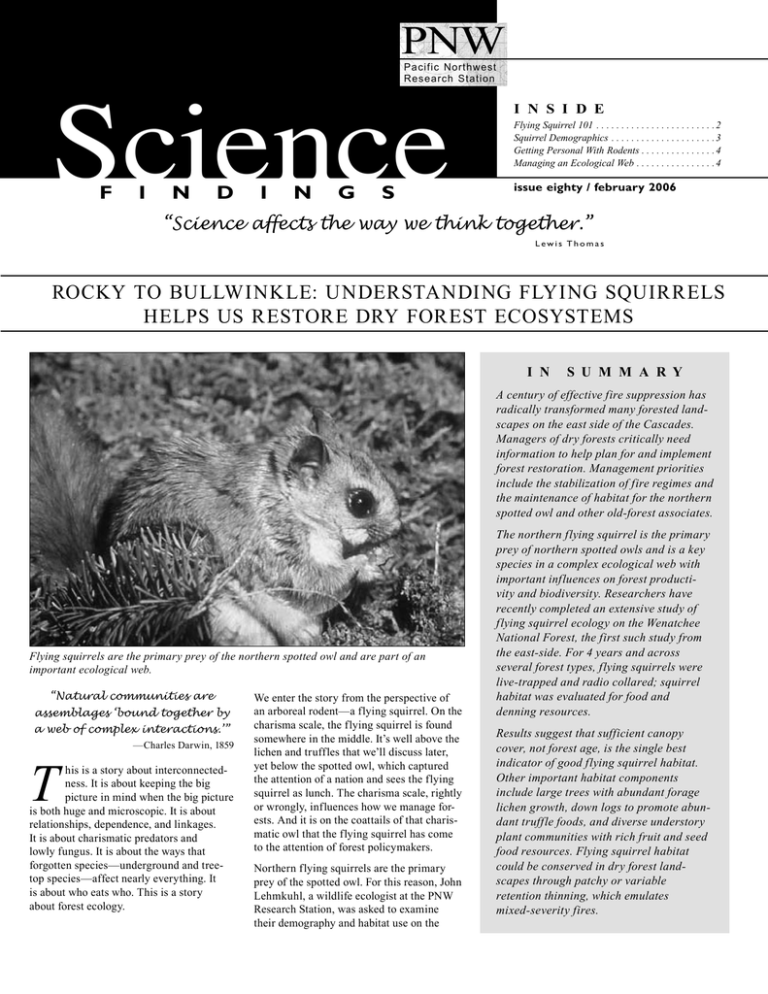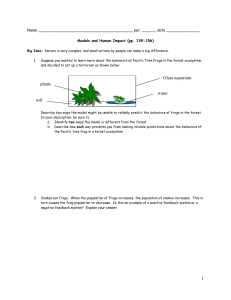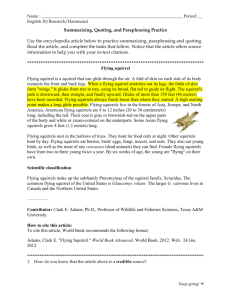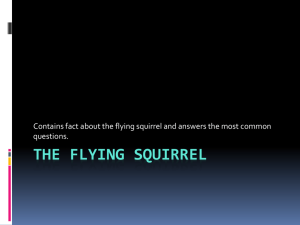PNW
advertisement

PNW Pacific Northwest Research Station I n s i d e Flying Squirrel 101 . . . . . . . . . . . . . . . . . . . . . . . . Squirrel Demographics . . . . . . . . . . . . . . . . . . . . Getting Personal With Rodents . . . . . . . . . . . . . . . Managing an Ecological Web . . . . . . . . . . . . . . . . F I N D I N G S 2 3 4 4 issue eighty / february 2006 “Science affects the way we think together.” Lewis Thomas ROCKY TO BULLWINKLE: UNDERSTANDING FLYING SQUIRRELS HELPS US RESTORE DRY FOREST ECOSYSTEMS IN S U M M A R Y A century of effective fire suppression has radically transformed many forested landscapes on the east side of the Cascades. Managers of dry forests critically need information to help plan for and implement forest restoration. Management priorities include the stabilization of fire regimes and the maintenance of habitat for the northern spotted owl and other old-forest associates. Flying squirrels are the primary prey of the northern spotted owl and are part of an important ecological web. “Natural communities are assemblages ‘bound together by a web of complex interactions.’” T —Charles Darwin, 1859 his is a story about interconnectedness. It is about keeping the big picture in mind when the big picture is both huge and microscopic. It is about relationships, dependence, and linkages. It is about charismatic predators and lowly fungus. It is about the ways that forgotten species—underground and treetop species—affect nearly everything. It is about who eats who. This is a story about forest ecology. We enter the story from the perspective of an arboreal rodent—a flying squirrel. On the charisma scale, the flying squirrel is found somewhere in the middle. It’s well above the lichen and truffles that we’ll discuss later, yet below the spotted owl, which captured the attention of a nation and sees the flying squirrel as lunch. The charisma scale, rightly or wrongly, influences how we manage forests. And it is on the coattails of that charismatic owl that the flying squirrel has come to the attention of forest policymakers. Northern flying squirrels are the primary prey of the spotted owl. For this reason, John Lehmkuhl, a wildlife ecologist at the PNW Research Station, was asked to examine their demography and habitat use on the The northern flying squirrel is the primary prey of northern spotted owls and is a key species in a complex ecological web with important influences on forest productivity and biodiversity. Researchers have recently completed an extensive study of flying squirrel ecology on the Wenatchee National Forest, the first such study from the east-side. For 4 years and across several forest types, flying squirrels were live-trapped and radio collared; squirrel habitat was evaluated for food and denning resources. Results suggest that sufficient canopy cover, not forest age, is the single best indicator of good flying squirrel habitat. Other important habitat components include large trees with abundant forage lichen growth, down logs to promote abundant truffle foods, and diverse understory plant communities with rich fruit and seed food resources. Flying squirrel habitat could be conserved in dry forest landscapes through patchy or variable retention thinning, which emulates mixed-severity fires. east side of the Washington Cascades. But for Lehmkuhl, that is where the emphasis on the owl ends. Lehmkuhl, who is based in Wenatchee, Washington, says if it were up to him the charisma scale would be smashed to bits. He doesn’t favor any one species over another. Instead, he is interested in the linkages and relationships among species. Put in ecological parlance, Lehmkuhl studies “trophic dynamics.” “Flying squirrels are a link in a really neat ecological web,” he explains. “Flying squirrels primarily eat truffles, which are like underground mushrooms. The fungi that make truffles receive all their food from a host tree root and, in turn, assist the tree in gathering essential minerals and nutrients. In this way, they are dependent on each other. By eating so many truffles, flying squirrels are an important disperser of undigested truffle spores, a process that is critical for the long term health of both truffles and trees. The trees, in turn, provide den sites for the squirrels, which keep them warm and safe from predators, like spotted owls. And that’s just the beginning.” His holistic perspective on forests has meant Lehmkuhl has become more than a wildlife K E Y FINDIN G S • Density of flying squirrels was high (0.9 per acre) in young and mature mixedconifer stands, and low (0.45 per acre) in ponderosa pine stands. Stands with more than 55 percent canopy cover supported high densities, whereas those with less than 55 percent cover had low squirrel density. • Density was as high in the eastern Cascades as in southwestern Oregon, and about fives times higher than in western Washington. • Survival and recruitment of flying squirrels was positively correlated with the number of understory species, the biomass of fungal truffles, and the biomass of epiphytic forage lichens (survival only). biologist. Tasked with unraveling the needs of the flying squirrel in dry, fire-prone forests, he has periodically doubled as a mycologist, botanist, and lichenologist. “It’s not like studying wildlife behavior or physiology, which are nice and tidy. Once you start into habitat relationships and trophic dynamics, things start getting really messy,” he says. According to Lehmkuhl, complexity is key to sound ecological thinking: “It is dangerous to become single-minded in our view of land management,” he says. “And, I think that sometimes happens with fire and fuels issues in dry forests. In their effort to reduce fire danger, the managers sometimes lose sight of the forest.” Owing, in part, to a legacy of effective fire suppression, spotted owl habitat (and thus flying squirrel habitat) in the eastern Cascades is at high risk of severe, stand-replacing wildfires. Increasingly, to protect the owl and its old-growth forest habitat from wildfire, there is a push to apply forest-thinning treatments and prescribed burning at massive scales. F lying Squirrels 101 A ccording to Lehmkuhl, if you live in the Pacific Northwest and you’ve never seen a flying squirrel, it’s probably because you haven’t looked at night. They are actually quite common. Flying squirrels are about 7 inches long— 12 if you count their tail—and weigh 4 to 6 ounces, roughly the same as a roll of pennies. At a glance, they look similar to their earthbound cousins. That is, unless you notice the large flap of skin that connects their front and hindlegs on each side. The skin gives them the confidence to break free of a tree-top perch and glide from tree to tree or to the ground. With their legs splayed, the skin is taut and wind resistant enough to permit a controlled descent, often 50-yards or more from the launch tree. This adaptation is efficient for moving through the forest and comes in particularly handy when being pursued through the canopy by a marten or fisher. “Flying squirrels are secondary cavity nesters,” explains Lehmkuhl. “This means they usually make their dens within old dead trees (also called snags) that have been excavated by woodpeckers. Typically, a greater abundance of large dead trees is associated with higher flying squirrel numbers. Interestingly, though, our recent work has shown that when snags aren’t available, flying squirrels will also utilize mistletoe brooms.” Mistletoe is a parasitic plant that grows in dense tangles in tree crowns. tree canopies. Lichens perform double-duty for the squirrels acting also as a nest material and insulator. “Because lichens are low in nutrients, they are considered mainly a survival-only winter food source,” he adds. Flying squirrels emerge from their dens each night to forage. Outside of the winter months, they are primarily interested in truffles. But because truffles are relatively low in nutrients, they also seek out seeds and nuts, which make up about 20 percent of their diet. To provide scientific information to people who make and influence decisions about managing land. “Unlike many rodents, flying squirrels don’t cache food for the winter. So, when snow and ice make it impossible to dig for truffles, they move on to a less palatable, albeit critical winter food source—arboreal forage lichens,” explains Lehmkuhl. These are the draping, beard-like organisms that hang in Science Findings is online at: http://www.fs.fed.us/pnw The site includes Science Update—scientific knowledge for pressing decisions about controversial natural resource and environmental issues. Purpose of PNW Science Findings PNW Science Findings is published monthly by: Pacific Northwest Research Station USDA Forest Service P.O. Box 3890 Portland, Oregon 97208 (503) 808-2137 Send new subscriptions and change of address information to pnw_pnwpubs@fs.fed.us Sherri Richardson Dodge, editor srichardsondodge@fs.fed.us Keith Routman, layout kroutman@fs.fed.us United States Department of Agriculture Forest Service 2 Squirrel Demographics U ntil recently, most flying squirrel research has been done on the west side of the Cascades, where spotted owls are most abundant and, therefore, interest has been highest. Lehmkuhl was the first to take a close look at squirrel demography in the drier, fire-prone forests on the east side of the mountains. “Dry forests are being targeted for large-scale treatments to reduce fire hazard and restore ecosystems,” says Lehmkuhl. “Our research can help land managers understand the implications of dry forest fuels management on the ecological web of arboreal rodents, their habitat, truffles, lichens, and spotted owls.” Lehmkuhl and his field crew live-trapped flying squirrels on the Cle Elum Ranger District, Wenatchee National Forest during the fall from 1997 to 2000. The traps were distributed through three forest-cover types: open ponderosa pine, young mixed-conifer, and mature mixed conifer. They set hundreds of traps— both on the ground and mounted breast high on trees—and baited them with a mixture of oats, peanut butter, and molasses. “We caught tons of chipmunks,” says Lehmkuhl. “In any given 2-week trapping period in a particular stand we’d catch maybe 40 chipmunks, 25 flying squirrels, 5 bushytailed woodrats, and maybe a golden mantled ground squirrel or a skunk. Sometimes we’d even catch weasels that were attracted to the trapped rodents.” By the end, they had caught 879 different flying squirrels. West-side researchers have uncovered several patterns that describe flying squirrel distribution at local and regional scales. This gave Lehmkuhl a set of hypotheses to test on eastside squirrel populations. Hypothesis one: At a local scale, there are more flying squirrels where forests are older and more complex. “The rationale for this hypothesis is based on the fact that complex, older forests typically have more big snags for den sites, more down logs and shrubs that are associated with greater truffle and plant food abundance, and more forage lichens for winter food,” says Lehmkuhl. “But we found that canopy cover, not forest age, was most correlated with flying squirrel abundance. Surprisingly, the young and mature mixed-conifer forests had similarly high densities. We had expected the abundant snags in the older forest to result in greater squirrel densities. But it seems that the mistletoe brooms, which were common in young stands, compensated for the lack of snags. About 35 percent fewer individuals were captured in the open pine forest, which appears to be poorer habitat than the mixed-conifer forests,” says Lehmkuhl. Hypothesis two: At a regional scale, flying squirrel abundance increases along a northsouth, temperature-moisture gradient. This hypothesis is based on research done by Andy Carey, a now retired PNW scientist, who found increasing flying squirrel densities in a gradient from western Washington to southwestern Oregon. “Based on our findings, Carey’s hypothesis can be extended to the east, over the mountains,” says Lehmkuhl. “Density was as high in our eastern Cascades sites as in Carey’s southwestern Oregon sites, and about five times higher than in his western Washington sites.” Flying squirrels were live-trapped in three forest-types: open ponderosa pine (top), mature mixed-conifer (center), and young mixed-conifer (bottom). The mixed conifer forests provided better squirrel habitat by virtually every measure. Density of flying squirrels was high in young and mature mixed-conifer stands, and low in ponderosa pine stands. 3 Getting personal with rodents I t was not enough for Lehmkuhl to simply know the population density of flying squirrels. To unravel the ecological web and understand the reasons for observed patterns, he needed to know where they went, what they ate, and how much food was available to them. He radio collared several squirrels in each forest type and followed them, night after night, to discern how far they traveled to find the food they needed. In this way, a comparison of home ranges is an implicit comparison of habitat quality—a smaller home range equates to more available food and, thus, better habitat. “Home ranges were 85 percent larger in pine forest. On average, the squirrel home ranges were 11 acres in the pine forest compared to just 6 acres in the mixed-conifer forests,” says Lehmkuhl. To estimate winter food availability he measured lichen diversity and biomass in all three forest types. Once again, the young and mature mixed-conifer stands proved to provide the better squirrel habitat compared with the open pine forest. Forage lichen biomass was a strong indicator of over winter survival and may be a critical habitat component in long, cold winters when there is little other food available. “By nearly all measures, open pine forest was clearly poorer habitat for northern flying squirrels compared to young or mature mixed-conifer forests. More surprisingly, though, there were no apparent differences in habitat quality between the young and mature mixed conifer. This is contrary to some of the conventional wisdom regarding flying squirrels’ dependence on old-growth forest,” says Lehmkuhl. Again, there was no difference between the young and mature mixed-conifer habitat. And what were they eating, and how does diet relate to density, recruitment, and survival? To identify what was on the menu, Lehmkuhl and his crew examined fecal pellets from 318 flying squirrels under a microscope. “Flying squirrel diets in our eastern Cascade forests were similar in composition to squirrel diets in other parts of the Pacific Northwest,” he explains. “They consisted of approximately 80-percent truffles and 20-percent plant material. And there was no difference in diet between forest types.” However, compared to pine forests, he found that truffles were more abundant in young and mature forests, which accounted for higher recruitment rates and density in those forests. Good recruitment and survival also were associated with understories rich in seed and fruit-bearing plants. More than 1,500 traps were set throughout the Cle Elum Ranger District, Wenatchee National Forest during the fall from 1997 to 2000. M anaging an ecological web W here do we go with these findings? How can they assist in the restoration of dry forests? We know that east-side forests aren’t what they used to be. A century of fire suppression has produced denser forests than those that existed historically. And for now, this has been good for flying squirrels; snags and down wood abound, canopies have closed, and truffles are more abundant than ever. The down side comes when a stand-replacing fire wipes out squirrel habitat all together—an event that is likely inevitable in the dense, closed-canopy forests the flying squirrel prefers. When thinking about restoration, Lehmkuhl urges caution. Not surprisingly, he hopes for a holistic approach. “Current forest management in the dry forest zone represented by our study area is focused on conserving habitat for the northern spotted owl, restoring characteristic fire regimes, and restoring dry forest ecosystems,” says Lehmkuhl. Often, restoration of dry forest habitat is accomplished through aggressive thinning and prescribed burning resulting in sparse, park-like forests, not unlike the open pine stands in Lehmkuhl’s study. Based on his findings, land managers may want to re-think their approach if their restoration objectives continue to include flying squirrel and spotted owl habitat conservation. “There are ways to lower the risk of standreplacing fires while also conserving squirrel habitat and its ecological web,” says Lehmkuhl. Landscape treatments could emulate a mixed-severity fire—the kind that creeps along, skipping large patches and lightly thinning others, punctuated by periodic flareups that kill large patches. W RITER ’ S PROFILE Jonathan Thompson is a science writer and ecologist. He lives in Corvallis, Oregon. 4 Truffles make up more than 80 percent of flying squirrels’ diet. Not surprisingly, therefore, forest stands with higher truffle abundance had greater squirrel survival and recruitment. According to Lehmkuhl, any disturbance— fire or logging—that maintains patches of continuous canopy but also opens it up enough to increase understory plant richness and decrease the amount of fuel should help. “It’s important that there be some level of patchiness and diversity across the landscape,” he notes. “We found that tree canopy cover was the single best correlate of squirrel density, with an apparent threshold of 55-percent canopy cover separating stands with low- from highdensity populations. This threshold may be helpful to managers who are trying to balance fuel reduction with habitat needs.” “If you’re only going to treat a small percentage of the landscape, then perhaps it’s not such a big deal; there will always be some closed-canopy forest. But if you’re treating, Forage lichens are a critical winter food source for flying squirrels, which, unlike many other rodents, do not cache food stores. Lichens are also used as nest material, helping to insulate and protect flying squirrels through the cold months. say, 50 percent or more, then it’s important to be thinking about mitigation,” says Lehmkuhl. During the past decade, federal agencies, like the Forest Service, have reconsidered the traditional underpinnings of land management and replaced them with those of ecosystem management. This reflects a move away from single-mindedness and the charisma scale and toward an appreciation of the interconnectedness of natural systems. As the restoration of dry landscapes gains momentum, hopefully ecosystem management will focus on the linkages that bind all things together. “Never forget that every single organic being around us may be said to be striving to the utmost to increase its number.” —Charles Darwin L A ND M A N AG E M ENT I M PLIC A TIONS • Dry forest restoration treatments that reduce canopy cover, reduce the number of large trees and down logs, and promote dry, species-poor understories will negatively impact the local population of flying squirrel. FOR F U RT H E R R E A DI NG Lehmkuhl, J.F. 2004. Epiphytic lichen diversity and biomass in low-elevation forests of the eastern Washington Cascade Range, USA. Forest Ecology and Management. 187: 381–392. Lehmkuhl, J.F. 2005. Wildlife adaptations and management in eastside interior forests with mixed-severity fire regimes. Proceedings of the symposium on mixedseverity fire regimes: ecology and management. Misc. publ. 3. Davis, CA: The Association for Fire Ecology. Lehmkuhl, J.F.; Gould, L.E.; Cázares, E.; Hosford, D.R. 2004. Truffle abundance and mycophagy by northern flying squirrels in eastern Washington. Forest Ecology and Management. 200: 49–65. Lehmkuhl, J.F.; Kistler, K.D.; Begley, J.S.; Boulanger, J. [In press]. Demography of northern flying squirrels informs ecosystem management of Western interior forests. Ecological Applications. Lehmkuhl, J.F.; Kistler, K.D.; Begley, J.S. [In press]. Bushy-tailed woodrat abundance in dry forests of eastern Washington. Journal of Mammalogy. • Patchy or variable-retention thinning consistent with emulating mixed-severity fires in dry forest stands would maintain some stand-level habitat elements associated with truffle or lichen production (closed-canopy, woody debris, large trees) and would, therefore, benefit flying squirrel populations. • Negative stand-level impacts of fuel reduction treatments potentially would be traded for the positive effects of long-term stable fire-resistant landscapes and persistent old-forest habitat for spotted owls and other species. 5 F I N D I N G PRSRT STD US POSTAGE PAID PORTLAND OR PERMIT N0 G-40 S U.S. Department of Agriculture Pacific Northwest Research Station 333 SW First Avenue P.O. Box 3890 Portland, OR 97208-3890 Official Business Penalty for Private Use, $300 scientist profilE JOHN F. LEHMKUHL is a research wildlife biologist with USDA Forest Service, PNW Research Station. He is a member of the Eastside Forest Health Restoration team, Managing Disturbance Regimes Program. Lehmkuhl earned a Ph.D. in forest resources and wildlife science from the University of Washington, an M.S. in wildlife biology from the University of Montana, and a B.S. in wildlife biology from Humboldt State University. He has worked in various research, professional, and technical positions for the Forest Service and the National Park Service, and he was a volunteer with the Peace Corps/Smithsonian Environmental Program in Nepal. Lehmkuhl has specialized in the ecology and management of south Asian tropical forests and grasslands. His current research and management interests are the integration of wildlife and disturbance ecology for managing Pacific Northwest forests. Other research and conservation interests include the ecology of large herbivores, mammalian ecology, and grassland ecology. Lehmkuhl can be reached at: USDA Forest Service Pacific Northwest Research Station 1133 N. Western Avenue Wenatchee, Washington 98801 Phone: (509) 664-1737 E-mail: jlehmkuhl@fs.fed.us COLL A B OR A TORS Keith Kistler, James Begley, Eastside Forest Health Restoration Team, PNW Research Station John Boulanger, Integrated Ecological Research, Nelson, British Columbia, Canada Efren Cázares, Forest Science Department, Oregon State University David Hosford, Laura Gould, Department of Biological Sciences, Central Washington University Eric Forsman, Ecology, Management, and Conservation of Sensitive Wildlife Species team, PNW Research Station The U.S. Department of Agriculture (USDA) prohibits discrimination in all its programs and activities on the basis of race, color, national origin, age, disability, and where applicable, sex, marital status, familial status, parental status, religion, sexual orientation, genetic information, political beliefs, reprisal, or because all or part of an individual’s income is derived from any public assistance program. (Not all prohibited bases apply to all programs.) Persons with disabilities who require alternative means for communication of program information (Braille, large print, audiotape, etc.) should contact USDA’s TARGET Center at (202) 720-2600 (voice and TDD). To file a complaint of discrimination, write USDA, Director, Office of Civil Rights, Room 1400 Independence Avenue, SW, Washington, DC 20250-9410 or call (800) 795-3272 (voice) or (202) 720-6382 (TDD). USDA is an equal opportunity provider and employer.





